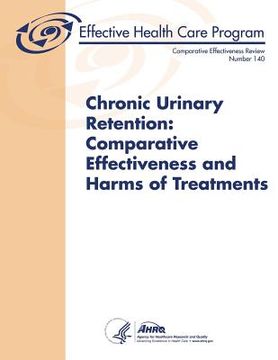Chronic Urinary Retention: Comparative Effectiveness and Harms of Treatments: Comparative Effectiveness Review Number 140 (en Inglés)
Reseña del libro "Chronic Urinary Retention: Comparative Effectiveness and Harms of Treatments: Comparative Effectiveness Review Number 140 (en Inglés)"
Persistent partial retention of urine or chronic urinary retention (CUR) is a common problem for which we have little understanding in terms of prevalence, natural history, prognosis, or efficacy and comparative effectiveness of treatments. Also unclear are whether and when to suspect, screen, or treat patients for CUR. Standard diagnostic criteria (including the duration and volume of post-void residual [PVR] urine necessary for a diagnosis) have not been established for chronic urinary retention. Researchers often define CUR as PVR urine volume greater than 300 ml; however, some studies define it as 100 ml, 400 ml, or 500 ml. CUR may be either asymptomatic or associated with lower urinary tract symptoms such as urinary frequency, urgency, or incontinence. Elevated PVR or CUR can increase risk for urinary tract infections (UTI) and renal failure. Some studies of men with lower urinary tract symptoms and CUR indicate increased risk of acute urinary retention (AUR), renal failure, and lower likelihood that benign prostatic hypertrophy surgery will improve urinary symptoms. A threshold PVR urine volume associated with these consequences is unclear, although negative outcomes have been demonstrated in men with PVR volumes over 500 ml. We do not know if these findings are applicable to asymptomatic CUR. CUR is almost always caused by another (often concomitant) medical condition. Causes of CUR are commonly categorized as obstructive or non-obstructive. In men, the most prevalent obstructive cause is bladder outlet obstruction associated with benign prostatic enlargement. As many as 25 percent of men who undergo prostate surgery for benign prostatic enlargement have CUR. Obstructive causes of CUR in women include complications from surgery for stress urinary incontinence and pelvic organ prolapse. In both sexes, urethral strictures and pelvic masses are obstructive causes. CUR not caused by obstruction is typically due to detrusor underactivity, which can be neurogenic (damage to nerves that innervate the bladder in conditions such as multiple sclerosis, spinal cord injury) or myogenic (damage to the smooth muscle of the bladder). An additional non-obstructive cause of CUR is Fowler's syndrome, which affects mainly young women, is characterized by urinary retention due to a failure of urethral sphincter relaxation, and is not well recognized in the United States. The goal treatment is to improve function and/or quality of life and reduce complications to an extent meaningful to patients. Treatment and management options depend on etiology. Most approaches (including surgery, minimally invasive procedures, and drugs) address the underlying condition or mechanical cause (e.g., benign prostatic enlargement, neurogenic bladder) rather than specifically addressing CUR. When treatment fails to alleviate CUR, catheterization can be used for bladder management. Harms are specific to the interventions and may include infection and surgical complications. Our review addresses the following Key Questions: Key Question 1: What are the effectiveness and comparative effectiveness of treatments for chronic urinary retention in adults? a. With male-specific etiologies? b. With female-specific etiologies? c. With non sex-specific etiologies d. What patient or condition characteristics (e.g., age, severity, etc.) modify the effectiveness of treatment? Key Question 2: What are the harms and comparative harms of treatments for chronic urinary retention in adults? a. With male-specific etiologies? b. With female-specific etiologies? c. With non sex-specific etiologies? d. What patient or condition characteristics (e.g., age, severity, etc.) modify the harms of treatment?

